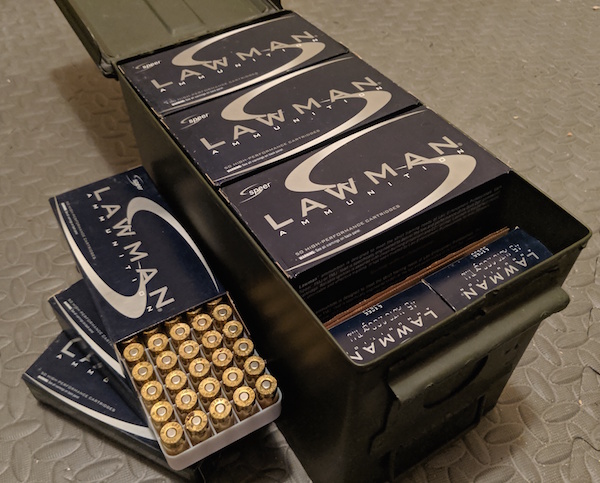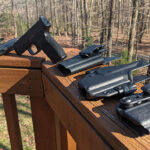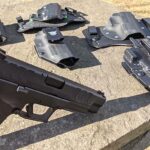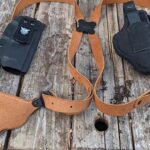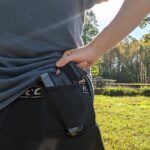There are subtleties to every shooters approach, some have honed their craft and excel in the world of competition shooting. However, many are still trying to figure out what works for them on the shooting range. One common question is whether you should close an eye when you shoot? Shooting with one eye closed is usually best suited to pinpoint accuracy and for beginner shooters. Whereas, shooting with both eyes open is best when situational awareness is key and a skill suited to more experienced shooters. Depending on what you are training for will dictate whether you shoot with a closed eye.
Table of Contents
Finding Your Dominant Eye
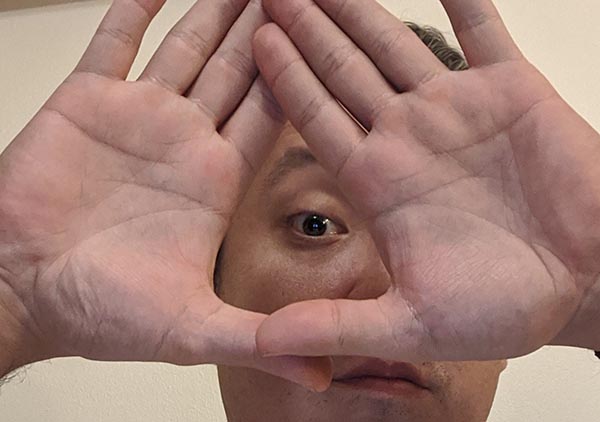
Shooting With One Eye Closed
Whether you shoot with one eye closed, or both eyes open, there are benefits to each approach. Contrarily, each method also has weaknesses. First, I’m going to discuss the one eye closed method of shooting.
Pros of Shooting With One Eye Closed
Generally, beginner shooters find closing one eye results in more accurate shots. Usually, new shooters are trying to figure out a host of other shooting basics, including range safety, gripping the pistol, stance, and more. Closing the non-dominant eye makes acquiring the proper sight picture easier and can help diagnose shooting problems.
Moreover, narrowing the field of vision by closing one eye prevents distraction from influences in your peripherals. Essentially, you are blocking out any movement from the shooter in the lane next to you.
Finally, those who are cross-eye dominant can better achieve proper sight alignment when the non-dominant eye is closed. Other shooters with the same dominant eye and hand have an easier time aligning their sights. See the below image for a better explanation.
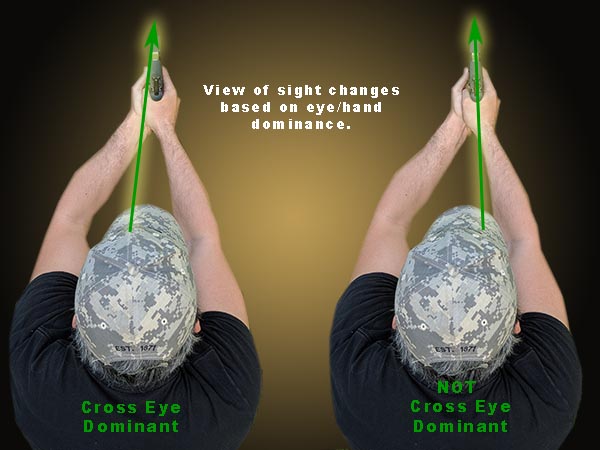
So to recap, here are the benefits of closing the non-dominant eye when shooting:
- Makes acquiring proper sight picture easier
- Forces the shooter to focus on a single point
- Narrows field of vision to prevent distraction
- May help cross-eye dominant shooters
Cons of Closing An Eye While Shooting
Shooting with on eye closed has many benefits. Closing one eye is great for focusing on fine accuracy. However, when it comes to personal defense, closing one eye and cutting your field of vision in half can leave you at a disadvantage. After all, our vision is probably the most relied upon sense for most of the population. Cutting that in half is not ideal.
Time is another factor to consider when aiming down the sights in a personal defense situation. Oftentimes, drawing the gun and aiming are done in one smooth motion for shooters who keep both eyes open. However, most one eye shooters wait until the pistol is completely pushed out to the target before acquiring proper sight picture. Generally, this is because they lack the ability to focus with both eyes open.
Finally, shooters who become reliant on closing one eye when shooting may struggle with sight picture under duress. In a self defense scenario, the target may not be coming directly at you. Tracking movement with only one eye is far more difficult than having the ability to use both eyes. You can read more about that here, but suffice it to say that “studies have shown that adults who lose the sight in one eye have declines in their abilities to accurately track moving objects, to judge distances, and to perceive depth.“
Another quick recap about the cons of shooting with one eye closed:
- cuts your field of vision in half
- increases time to aim
- more difficult to track movement
Shooting With Both Eyes Open

Now that we’ve discussed the problems and benefits of shooting with a closed eye, lets examine the two eye open method. Although this is my preferred method of shooting, I’m still training even now on doing this effectively.
Pros Of Shooting With Both Eyes Open
Essentially, every con mentioned in the above section is negated when shooting with both eyes open. First, you’ll keep 100% of your peripheral vision intact. Therefore, you can react if you are engaged by another threat coming from your non-dominant eye side.
Next, you’ll be able to attain proper sight picture as you put the muzzle on target. Being able to un-holster your firearm and attain proper sight picture as you push out is the quickest way to engage a threat.
Finally, as we’ve established, tracking movement with one eye closed is more difficult. An assailant is hardly going to stand upright directly in front of your muzzle. Having both eyes open will allow you to better track movement to either your dominant or non-dominant side.
- peripheral vision intact
- obtain sight alignment as you push out to target
- can track movement easier with both eyes open
Cons Of Shooting With Both Eyes Open
The biggest problem with shooting with both eyes open is the time it takes to master this technique. Training your eyes to attain and maintain proper sight picture as you push out toward your target takes an abundance of dedicated practice.
Additionally, maintaining this skill takes continual repetitions. Having lived next to a shooting range in the past (less than 3 miles from door to door), I can honestly say that my abilities were much better when my practice regiment was more regular. Like any muscle, failing to exercise this skill will lead to its degradation.
- extensive practice is required to develop this skill
- skill will expire without continued practice
So Which Method Is Better?
Alright, so lets get down to which method is better. Should you should with one eye closed or both eyes open? If you are a beginner, just learning your way around a firearm then shooting with one eye closed is beneficial. However, if you’re training for personal defense and are a more experienced shooter, then I recommend working on shooting with both eyes open.
Beginner shooters have plenty to think about when they visit the range. Everything from range safety to how to operate the handgun will be running through their mind. Once they are comfortable with shooting in general, then you can introduce a new skill to their arsenal. However, initially work on getting consistent and tight groupings with one eye closed before proceeding.
Experienced and advanced shooters should develop this skill. Those whose main goal is personal defense should be able to shoot effectively with both eyes open. Being aware of your surroundings, analyzing threats, and tracking a moving target are all essential to someone training with a firearm for self defense.
Parting Shots
Hopefully this article has provided some insights about the two different methods of shooting. Do you shoot with one eye open or two? Leave a comment below and let me know if I missed anything. Also, if you have any questions, please feel free to ask.


